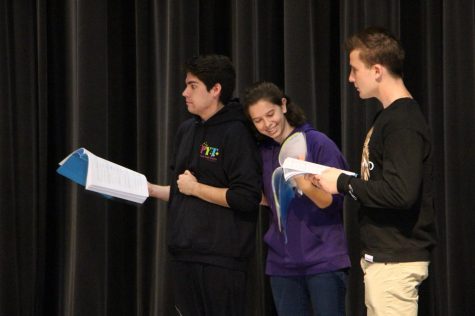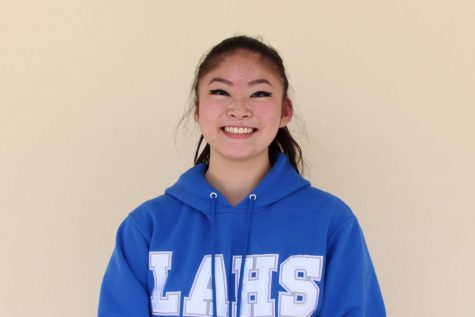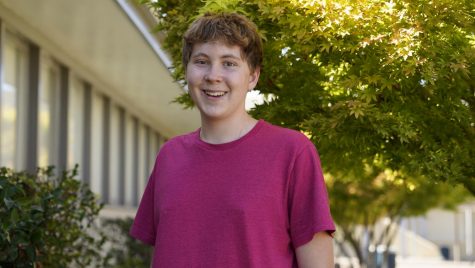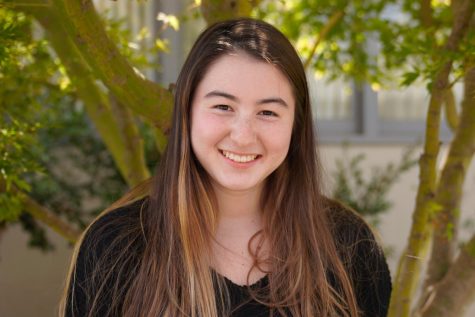Broken Box: From Script to Stage
October 23, 2017

Broken Box members, from left to right, Braden Koch, Jessica Aaron and Jake Jakimsen rehearse a scene from their upcoming play, “The Lonely Hearts Club.” The cast spends seven weeks to prepare for each of their plays in order to fully thresh out their characters and settings.
Broken Box, Los Altos’ Acting II course, remains an enigma to many. Its members can be seen in character promoting productions on the morning announcements, or sprinting through the quad in end of the year initiation rituals. But in the theater, their talent and hard work shines three times a year as they perform stories from all-age comedies to critiques of social inequality.
To understand this feat, The Talon took a look inside the seven-week process of putting on a play.
Picking a Play
Acting teacher Nancy Moran directs and chooses the plays. Her first selection this year is the never-performed murder mystery/comedy, “The Lonely Hearts Club,” written by Don Zolidis. Moran chooses comedy plays as the first show Broken Box puts on to encourage bonding and provide an easy entry point for new actors and audiences. The first students to receive the script are costume designers senior Allison Wang and her mentee junior Chamu Palaniappan. They begin outlining ideas for each character’s costume, which are solidified only when they see the actors perform.
“We can tell from the words what the character is like, but watching them act it out is much different,” Allison said. “You see more personality, something more human.”
Week 1: Auditions
The actors begin with a read-through of the script to decide the role they want. Moran assigns roles based on auditions and actors’ preferences. Sound designer sophomore Tom Hocquet notes the sounds the script indicates, then searches YouTube for sounds or produces them himself using everyday objects.
Weeks 2-6: Rehearsals
After the actors receive their roles, Moran blocks the play and instructs actors how and where to move while the rest memorize lines. Senior Beatriz Valente, a third year member of Broken Box, says guidance from returning actors helps new actors adjust to Broken Box’s fast pace.
“There’s always more that you can do and more that you can help other people with,” Beatriz said. “You’re always adapting to figure out how to add to the community and the whole process.”
Beatriz takes an active role in connecting to all actors, helping others read lines and getting to know people. The collaborative aspect of the process shapes the cohesive dynamic Moran has noticed especially in this year’s cast.
“The returning members are the ones who are really making the effort to make sure everybody feels comfortable,” Moran said. “I don’t sense any clique-y-ness or that attitude of ‘them and us,’ which helps the dynamic of the group.”
One character costume Allison and Chamu changed according to the actor is Cindy, an eccentric, blindly optimistic character.
“When we read Cindy, she was a bit of a wildcard,” Allison said. “But when we look at Rachel, [the actor playing Cindy], it’s a little bit clearer to see which direction we should pursue and how we can complement her acting style and her attitude as Cindy.” They relay their adjustments to stage manager sophomore Sydney Enthoven, who adjusts the lights accordingly. Sydney also manages the props and helps read lines for absent actors.
To advertise the show, sophomore Mia Van Deloo serves as Public Manager, a new position created this year by Moran. Mia creates posters and writes scripts for announcements, enticing people to watch the show. Allison, Chamu, Sydney and Mia’s work is often underappreciated by those who do not understand their role in the process of putting together the play.
“I think it’s important everyone knows without the tech people, the actors would just be standing on a dark stage with no costume, no blocking and no sound,” Sydney said. “We put a lot of work into creating the show as well.”
Week 7: Tech week and shows
The four-week rehearsal period culminates in three days of tech, where actors and tech members stay after school to run the show with blocking, sound, lighting and costumes. The show is performed Thursday, Friday and Saturday. During the show, Allison and Chamu apply makeup and make costume adjustments, Tom controls the sound booth and Sydney announces cues for lights and sound. The shows end with a cast party, before the process starts again the next week.
Moran attributes the outstanding performances the students put on as tributes to their dedication.
“It’s new every time, it’s exciting,” Moran said. “Seeing different kids in different types of roles and watching them really take ownership is what makes me love this job. I can do the directing but they have to be the ones who really follow through.”





